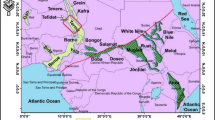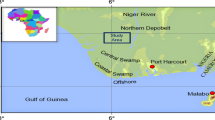Abstract
Foroozan field, with seven different reservoir layers, is one of the complex fields in the Persian Gulf. The purpose of this study was to identify intra-reservoir compartmentalisation using geochemical and reservoir engineering evidences. On the basis of this approach, 11 gaseous samples, which belong to different wells producing from the Burgan reservoir of Foroozan field, were selected. Gas composition, gas isotopes and associated oil bulk properties were tested to determine the reservoir continuity through the Burgan reservoir. In addition, fluid contacts and properties are also used to investigate reservoir continuity. Regarding clear differences in gas composition such as hydrogen sulphide concentrations, at least two separate segments in the north and south of the reservoir were detected. Moreover, the percentages of the different gas components indicated two separate compartments. Other evidences such as \(\hbox {C}_{1}\)–\(\hbox {C}_{4}\) alkane isotopic compositions and sulphur and nitrogen isotopic signatures confirmed the Burgan reservoir compartmentalisation. A number of petroleum bulk properties confirmed gradual variations that provide supplementary evidence on the reservoir-filling direction, signifying that fluids equilibrium had not been extended through the Burgan reservoir, laterally. Initial reservoir condition, different original water–oil contacts, solution gas–oil ratio at original pressure and bubble point pressure are other reservoir engineering evidences that support the Burgan reservoir compartmentalisation.







Similar content being viewed by others
References
ASTM 2011 D-4052: Standard for density, relative density, and API gravity of liquids by digital density meter; American Society for Testing Materials Standards.
Beeunas M A, Baskin D K and Schoell M 1999 Application of gas geochemistry for reservoir continuity assessment and identification of fault seal breakdown, South Marsh Island 61, Gulf of Mexico; In: AAPG Hedberg research conference ‘natural gas formation and occurrence’, Durango, Colorado.
Berner U and Faber E 1988 Maturity related mixing model for methane, ethane and propane, based on carbon isotopes; Org. Geochem. 13(1–3) 67–72.
Chung H M, Gormly J R and Squires R M 1988 Origin of gaseous hydrocarbons in subsurface environments: Theoretical considerations of carbon isotope distribution; Chem. Geol. 71(1–3) 97–104.
Clayton C 1991 Carbon isotope fractionation during natural gas generation from kerogen; Mar. Pet. Geol. 8(2) 232–240.
England W A 2007 Reservoir geochemistry – A reservoir engineering perspective; J. Pet. Sci. Eng. 58(3–4) 344–354.
England W A, Muggeridge A H, Clifford P J and Tang Z 1995 Modelling density-driven mixing rates in petroleum reservoirs on geological time-scales, with application to the detection of barriers in the forties field (UKCS); Geol. Soc. London, Spec. Publ. 86(1) 185–201.
Galarraga F, Reategui K, Martïnez A, Martínez M, Llamas J F and Márquez G 2008 V/Ni ratio as a parameter in palaeoenvironmental characterisation of nonmature medium-crude oils from several Latin American basins; J. Pet. Sci. Eng. 61(1) 9–14.
Gill C E, Shepherd M and Millington J J 2010 Compartmentalization of the Nelson field, Central North Sea: Evidence from produced water chemistry analysis; Geol. Soc. London, Spec. Publ. 347(1) 71–87.
Hill R J, Jarvie D M, Zumberge J, Henry M and Pollastro R M 2007 Oil and gas geochemistry and petroleum systems of the Fort Worth Basin; AAPG Bull. 91(4) 445–473.
Hovadik J M and Larue D K 2010 Stratigraphic and structural connectivity; Geol. Soc. London, Spec. Publ. 347(1) 219–242.
Hwang R J and Baskin D K 1994 Reservoir connectivity and oil homogeneity in a large-scale reservoir; Geo 94(2) 529–541.
Internal Report of NIOC Exploration Directorate 2017 Geological and geophysical studies carried out on Persian Gulf and Abadan Plateau of the Islamic Republic of Iran.
Kaufman R L, Ahmed A S and Elsinger R L 1990 Gas chromatography as a development and production tool for fingerprinting oils from individual reservoirs: Applications in the Gulf of Mexico; In: GCSSEPM foundation ninth annual research conference proceedings, 1 October, pp. 263–282.
Levachéet D, Montel F and Walgenwitz F 2000 Deep offshore fluid evaluation/connectivity study; In: SPE annual technical conference and exhibition, Society of Petroleum Engineers.
Liu Q, Jin Z, Wu X, Liu W, Gao B, Zhang D, Li J and Hu A 2014 Origin and carbon isotope fractionation of \(\rm {CO_2}\) in marine sour gas reservoirs in the Eastern Sichuan Basin; Org. Geochem. 74 22–32.
Machel H G 1998 Gas souring by thermochemical sulfate reduction at 140\(^\circ \)C: Discussion; AAPG Bull. 82(10) 1870–1873.
Machel H G 2001 Bacterial and thermochemical sulfate reduction in diagenetic settings – Old and new insights; Sedim. Geol. 140(1–2) 143–175.
Márquez G, Escobar M, Lorenzo E, Gallego J R and Tocco R 2013 Using gas geochemistry to delineate structural compartments and assess petroleum reservoir-filling directions: A Venezuelan case study; J. S. Am. Earth Sci. 43 1–7.
Moldowan J M, Peters K E and Walters C C 2005 The Biomarker Guide: Biomarkers and Isotopes in Petroleum Systems and Earth History; Cambridge University Press, England.
Mougin P, Lamoureux-Var V, Bariteau A and Huc A Y 2007 Thermodynamic of thermochemical sulphate reduction; J. Pet. Sci. Eng. 58(3–4) 413–427.
Páez R H, Lawerence J J and Zhang M 2010 Compartmentalization or gravity segregation? Understanding and predicting characteristics of near-critical petroleum fluids; Geol. Soc. London, Spec. Publ. 347(1) 43–53.
Permanyer A, Douifi L, Lahcini A, Lamontagne J and Kister J 2002 FTIR and SUVF spectroscopy applied to reservoir compartmentalization: A comparative study with gas chromatography fingerprints results; Fuel 81(7) 861–866.
Permanyer A, Rebufa C and Kister J 2007 Reservoir compartmentalization assessment by using FTIR spectroscopy; J. Pet. Sci. Eng. 58(3–4) 464–471.
Prinzhofer A A and Huc A Y 1995 Genetic and post-genetic molecular and isotopic fractionations in natural gases; Chem. Geol. 126(3–4) 281–290.
Prinzhofer A, Mello M R, da Silva Freitas L C and Takaki T 2000 Chapter 9: New geochemical characterization of natural gas and its use in oil and gas evaluation; AAPG Memoir 73 107–119.
Rangel A, Katz B, Ramirez V and dos Santos Neto E V 2003 Alternative interpretations as to the origin of the hydrocarbons of the Guajira Basin, Colombia; Mar. Pet. Geol. 20(2) 129–139.
Rein E and Schulz L K 2007 Applications of natural gas tracers in the detection of reservoir compartmentalisation and production monitoring; J. Pet. Sci. Eng. 58(3–4) 428–442.
Schoell M 1980 The hydrogen and carbon isotopic composition of methane from natural gases of various origins; Geochim. Cosmochim. Acta 44(5) 649–661.
Schoell M 1983 Genetic characterization of natural gases; AAPG Bull. 67(12) 2225–2238.
Smalley P C and Hale N A 1996 Early identification of reservoir compartmentalization by combining a range of conventional and novel data types; SPE Form. Eval. 11(03) 163–170.
Whiticar M J, Faber E and Schoell M 1986 Biogenic methane formation in marine and freshwater environments: \(\rm {CO_2}\) reduction vs. acetate fermentation – isotope evidence; Geochim. Cosmochim. Acta 50(5) 693–709.
Zhang T, Amrani A, Ellis G S, Ma Q and Tang Y 2008 Experimental investigation on thermochemical sulfate reduction by \(\rm {H_2S}\) initiation; Geochim. Cosmochim. Acta 72(14) 3518–3530.
Zhu G, Zhang S, Liang Y, Dai J and Li J 2005 Isotopic evidence of TSR origin for natural gas bearing high \(\rm {H_2S}\) contents within the Feixianguan formation of the northeastern Sichuan Basin, southwestern China; Sci. China Ser. D. 48(11) 1960.
Acknowledgements
We are grateful to the National Iranian Oil Company–Exploration Directorate for granting us in this research. We also thank the Iranian Offshore Oil Company (IOOC) for accessing to the samples. The authors thank A Yahyaei from IOOC for his assistance. We also would like to thank the Institute of Geology and Geochemistry of Petroleum and Coal, RWTH Aachen University, GEO-data and Hydroisotop Companies for analysing the samples.
Author information
Authors and Affiliations
Corresponding author
Additional information
Corresponding editor: Partha Pratim Chakraborty
Rights and permissions
About this article
Cite this article
Hassanzadeh, P., Hezarkhani, A., Rabbani, A.R. et al. Integrating geochemical and reservoir engineering approach to evaluate reservoir continuity: A case study from Foroozan field, Offshore Iran. J Earth Syst Sci 128, 83 (2019). https://doi.org/10.1007/s12040-019-1105-x
Received:
Revised:
Accepted:
Published:
DOI: https://doi.org/10.1007/s12040-019-1105-x




